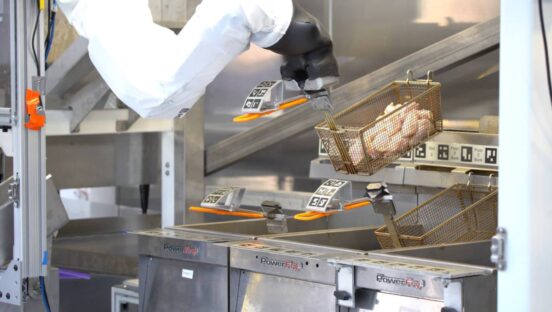With all the obstacles being thrown restaurants’ way lately, operators across the country are searching for ways to improve and optimize operations. Labor challenges, for example, are significantly impacting restaurants’ efficiency and their ability to serve customers. Recent data from the National Restaurant Association showed that four in five restaurants are understaffed, including 81 percent of full-service operations and 75 percent of limited-service operations.
This and other challenges, such as the increased demand for off-premises, are leading to an increasing number of operators turning to robotics and artificial intelligence (AI) sooner than they expected. What was anticipated to be a gradual shift over the next decade has instead been accelerated, with the COVID-19 pandemic as the catalyst. The industry has recognized that most, if not all, processes within a restaurant can be automated, which is why robotics and AI are alleviating many of the day-to-day headaches these issues have exacerbated.
Here are a few of the ways robotics and AI provide solutions to the problems that restaurants are facing today.
The Customer Experience Rules All
Thanks to the COVID-19 pandemic, and the increased demand for off-premises dining, now more than ever customers are expecting a flawless dining experience. When adding AI and robots to a restaurant, many processes are immediately simplified—even when understaffed—to ensure customers have that “perfect” experience.
One example is using technology to prepare dishes with accurate proportions, minimizing—if not eliminating—the probability of errors. One such tech solution is Picnic, a modular and configurable pizza assembly system commercially available in the market today that has been adopted by many restaurants to save time and money. Instead of having multiple staff members working the assembly line, the Picnic system uses the given restaurant’s existing menu to make up to 100 consistent pizzas per hour with a single, unassisted operator. Not only does this make running the kitchen easy, but now staff can focus on the quality of the food, brand identity, and, of course, providing a top-tier customer experience.
Time Is Money
Another immediate benefit of robots is the automation of repetitive, back-of-house tasks. A single robot can be used to complete a plethora of tasks such as cleaning silverware and cooking utensils along with keeping the kitchen area neat. This significantly reduces operating costs as robots can complete multiple tasks efficiently, while also working longer hours.
With robots being a part of the restaurant staff, operators don’t need to hire as many employees to cover different shifts throughout the day. Operators also don’t have to worry about fluctuating hourly wages when they use robots. After the initial investment, they stay at the same operating cost for years.
Miso, for example, incorporates robotics with AI, machine learning, analytics, and computer vision to provide impactful kitchen insights that help operators automate certain kitchen tasks, like frying and dispensing beverages, to run more efficient kitchens and free up employees’ time to dedicate to other responsibilities.
Accuracy Is Key
Agot.AI is a tech company that uses overhead cameras in restaurant kitchens and computer vision to analyze if staff are preparing orders correctly. Order accuracy has a huge impact on whether or not a customer because a repeat visitor. In 2021, fast food orders were accurate only 84 percent of the time—down from 2020—according to the American Customer Satisfaction Index. It’s no wonder that Agot.AI just closed a $10 million seed funding round.
Let’s fast forward a bit and think of a restaurant that relies on robots more than human labor. When it comes to customer service, robots can offer guidance as it pertains to navigating the experience, all while cooking and serving the food that is ordered and processing guests’ payments. It completely transforms what guests are used to when they go out to eat.
The acceleration of robots and AI in the restaurant industry was inescapable, and this type of technology will be critical in moving the restaurant industry forward. However, operators should keep in mind that customers will still seek human-to-human interaction when dining—as we’ve seen recently with the evolution of QR codes as customers returned to on-premises dining—so there will be a need to find a healthy balance between tech and humans.
Michael Schatzberg is co-founder and managing partner of Branded Strategic Hospitality, a New York City-based firm that invests in emerging technology in the restaurant and hospitality industries. Branded’s portfolio includes 27 companies, including Ovation, Chowly, TapRm, PourMyBeer, Minnow, and Bbot. To learn more about Branded, visit www.brandedstrategic.com.














